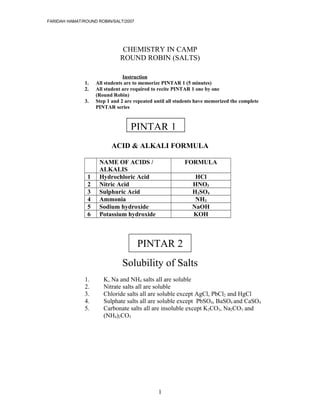Round robin english
- 1. FARIDAH HAMAT/ROUND ROBIN/SALT/2007 CHEMISTRY IN CAMP ROUND ROBIN (SALTS) Instruction 1. All students are to memorize PINTAR 1 (5 minutes) 2. All student are required to recite PINTAR 1 one by one (Round Robin) 3. Step 1 and 2 are repeated until all students have memorized the complete PINTAR series ACID & ALKALI FORMULA NAME OF ACIDS / ALKALIS FORMULA 1 Hydrochloric Acid HCl 2 Nitric Acid HNO3 3 Sulphuric Acid H2SO4 4 Ammonia NH3 5 Sodium hydroxide NaOH 6 Potassium hydroxide KOH PINTAR 2 Solubility of Salts 1. K, Na and NH4 salts all are soluble 2. Nitrate salts all are soluble 3. Chloride salts all are soluble except AgCl, PbCl2 and HgCl 4. Sulphate salts all are soluble except PbSO4, BaSO4 and CaSO4 5. Carbonate salts all are insoluble except K2CO3, Na2CO3 and (NH4)2CO3 1 PINTAR 1
- 2. FARIDAH HAMAT/ROUND ROBIN/SALT/2007 PINTAR 3 Preparing Soluble Salts 1. Acid react with reactive metal 2. Acid react with oxide metal 3. Acid react with carbonate metal 4. Acid react with alkali Chemical Equation 1. Acid reacts with reactive metal 2HCl + Zn ZnCl2 + H2 2. Acid reacts with oxide metal 2HNO3 + PbO Pb(NO3)2 + H2O 3. Acid reacts with carbonate metal H2SO4 + CaCO3 CaSO4 + CO2 + H2O 4. Acid reacts with alkali HCl + NaOH NaCl + H2O PINTAR 5 Colour of Oxide metal No Name of oxide metals Colour (hot) Colour (cold) 1 Copper(II) oxide Black Black 2 Lead oxide Brown Yellow 3 Zinc oxide Yellow White 4 Others oxide metals (common) White White Colour of Salts Bil Name of Salts Colour 1 Copper(II) carbonate Green 2 Copper(II) chloride, nitrate, sulphate Blue 3 Iron(II) Green 4 Iron(III) Brown 2 PINTAR 4
- 3. FARIDAH HAMAT/ROUND ROBIN/SALT/2007 5 Others White PINTAR 6 Cation Test 1(NaOH) White precipitate Pb2+ , Zn2+ , Al3+ [dissolve in excess] Ca2+ dan Mg2+ [cannot dissolve in excess] Green precipitate Fe2+ [ cannot dissolve in excess ] Brown preciptate Fe3+ [ cannot dissolve in excess] Blue precipitate Cu2+ [ cannot dissolve in excess] No precipitate NH4 + [alkali gas evolve ,NH3] Cation Test 2 (Ammonia aqueous) White precipitate Zn2+ , [dissolve in excess] Al3+ , Pb2+ and Mg2+ [cannot dissolve in excess] Green precipitate Fe2+ [cannot dissolve in excess] Brown precipitate Fe3+ [cannot dissolve in excess] Blue precipitate Cu2+ [dissolve in excess] Unchanged NH4 + , Ca2+ PINTAR 7 CONFIRMATION TEST IONS REAGENT OBSERVATION Pb2+ KI Yellow precipitate which dissolve in hot water Fe2+ Potassium hexacyanoferrate (II) Pale/Light blue precipitate Potassium hexacyanoferrate (III) Dark blue precipitate Potassium thiocyanate unchanged Fe3+ Potassium hexacyanoferrate (II) Dark blue precipitate Potassium hexacyanoferrate (III) Brown solution Potassium thiocyanate Blood red colouration CO3 2- React with acid Colourless gas bubbles produced Cl- AgNO3 solution White precipitate SO4 2- BaCl2 solution White precipitate NO3 - H2SO4 + FeSO4 + concentrated H2SO4 Brown ring produced 3
- 4. PINTAR 8 FARIDAH HAMAT/ROUND ROBIN/SALT/2007 ACTION OF HEAT ON SALTS NO TYPE OF SALTS REACTION PRODUCTS 1 Carbonate salts Metal oxide and CO2 2 Nitrate salts Metal oxide, Nitrogen dioxide(NO2) and oxygen (O2) 3 Sulphate salts -Sulphate salts all are not decompose except for Zinc sulphate, Copper(II)sulphate and Iron(III) sulphate. They decompose to produce metal oxide and sulphur trioxide (SO3) - Ammonium sulphate salts decompose to release ammonia gas and sulphuric acid vapour 4 Chloride salts Chloride salts all are not decompose except ammonium chloride. Its decompose to produce ammonia and hydrogen chloride THE HAPPY PEOPLE ARE THOSE WHO ARE PRODUCING SOMETHING, THE BORED PEOPLE ARE THOSE WHO ARE CONSUMING MUCH AND PRODUCING NOTHING Prepared by; Pn. Faridah Hamat Chemistry Panel SASER 2007 4


![FARIDAH HAMAT/ROUND ROBIN/SALT/2007
5 Others White
PINTAR 6
Cation Test 1(NaOH)
White precipitate Pb2+
, Zn2+
, Al3+
[dissolve in excess]
Ca2+
dan Mg2+
[cannot dissolve in excess]
Green precipitate Fe2+
[ cannot dissolve in excess ]
Brown preciptate Fe3+
[ cannot dissolve in excess]
Blue precipitate Cu2+
[ cannot dissolve in excess]
No precipitate NH4
+
[alkali gas evolve ,NH3]
Cation Test 2 (Ammonia aqueous)
White precipitate Zn2+
, [dissolve in excess]
Al3+
, Pb2+
and Mg2+
[cannot dissolve in
excess]
Green precipitate Fe2+
[cannot dissolve in excess]
Brown precipitate Fe3+
[cannot dissolve in excess]
Blue precipitate Cu2+
[dissolve in excess]
Unchanged NH4
+
, Ca2+
PINTAR 7
CONFIRMATION TEST
IONS REAGENT OBSERVATION
Pb2+
KI Yellow precipitate which dissolve in
hot water
Fe2+
Potassium hexacyanoferrate (II) Pale/Light blue precipitate
Potassium hexacyanoferrate (III) Dark blue precipitate
Potassium thiocyanate unchanged
Fe3+
Potassium hexacyanoferrate (II) Dark blue precipitate
Potassium hexacyanoferrate (III) Brown solution
Potassium thiocyanate Blood red colouration
CO3
2-
React with acid Colourless gas bubbles produced
Cl-
AgNO3 solution White precipitate
SO4
2-
BaCl2 solution White precipitate
NO3
-
H2SO4 + FeSO4 + concentrated
H2SO4
Brown ring produced
3](https://image.slidesharecdn.com/roundrobinenglish-101022065834-phpapp01/85/Round-robin-english-3-320.jpg)
